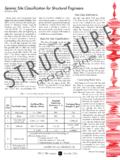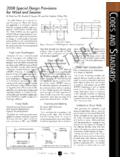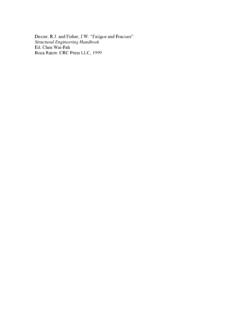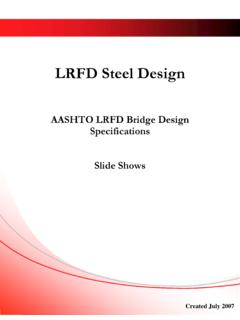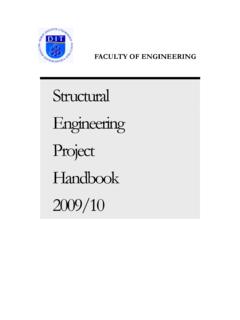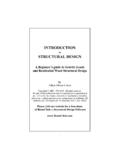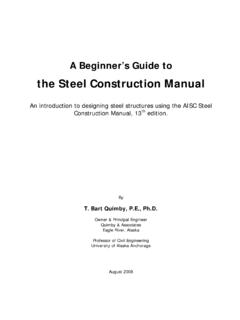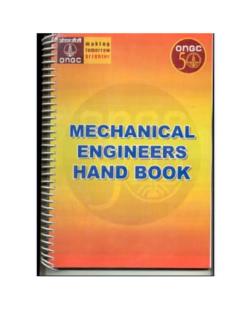Transcription of STRUCTURE
1 STRUCTURE .. Author's Handbo ok 2 015. Welcome! Please review our guidelines carefully. An understanding of STRUCTURE 's parameters for articles will provide you with a sound basis for submitting articles that end up in print! Thank you for your interest in STRUCTURE magazine. As a premier publication of the National Council of structural Engineers Associations (NCSEA), the structural engineering Institute (SEI) of ASCE, and the Council of American structural Engineers (CASE) of ACEC, STRUCTURE communicates with every member of the leading structural engineering associa- tions in the United States. STRUCTURE content is information readers refer to, time and again. We stress that the publication is a magazine. Our goal is to provide structural engineers with casual reading on mate- rials, techniques, professional issues, resources, and more.
2 With each article, we strive to provide a detailed overview STRUCTURE of the subject, and encourage readers to reach out for more The Practicing structural Engineer's Resource in-depth information. STRUCTURE is not a journal. Lengthy, in-depth papers are not standard fare in the magazine. Vision STRUCTURE magazine will be the premier Our publication is unique; its oversight is provided by an resource for practicing structural engineers. Editorial Board comprised of structural engineers repre- senting a wide cross-section of specialties. The Editorial Mission Board's oversight has made STRUCTURE magazine the pre- The Editorial Board will engage, enlighten, and mier resource for practicing structural engineers quality empower structural engineers by publishing content generated by SE's for SE's.
3 Interesting, informative, and inspirational content in STRUCTURE magazine that is professionally relevant, In addition to assisting in developing/maintaining the technically reliable, and intellectually refreshing magazine's annual Editorial Calendar, Editorial Board mem- Objectives bers are the primary contacts for STRUCTURE 's authors. Through STRUCTURE magazine, Whether an author is contacted by the magazine to write the Editorial Board will: an article, or he/she has presented an abstract that has Disseminate useful tips, tools, and techniques that been approved for a future issue, an Editorial Board mem- will help structural engineers increase the quality, ber is assigned to each article proposed for print. These productivity, and profitability of their work.
4 Shepherds assist authors with content, criteria, dead- Introduce new and innovative concepts lines, article reviews and more. in structural engineering through project descriptions, case studies, lessons learned, and We look forward to working with you! other approaches. Promote structural engineering as a true profession, not merely a technical avocation, and highlight how it is unique from the other design disciplines. STRUCTURE magazine Author's handbook 1. Article Guidelines and Rules Remember that articles must be of interest as information to the reader. In general, it is important to write articles that are infor- mative, timely, and practical to structural engineers. We remind authors that STRUCTURE magazine is not a refereed journal. As such, lengthy and detailed papers will not be accepted.
5 Appropriate content for STRUCTURE magazine includes Technical, Project, Product, InSights, and Forum articles, as well as Letters to the Editor; they should be original and not previously published or concurrently submitted elsewhere. Other general rules to remember while developing your Prospective authors may offer articles, or STRUCTURE maga- article include: zine may invite articles from individuals or organizations. No more than three authors will receive byline credits. No articles are guaranteed publication; all articles are sub- It is the primary author's responsibility to obtain article ject to the same scrutiny before acceptance, regardless of approval from all author's prior to submission. If the the source. Publisher encounters disagreement between authors at For invited articles, STRUCTURE magazine may provide an the time of layout review, it is likely that the article will abstract to guide the author on key points of interest.
6 Be pulled until the issues are resolved. No more than 3 to 5 graphics (including all photographs, Editorial Board members are assigned to articles and authors figures and drawings) should accompany articles, unless to clarify requirements and assist with content. These Shep- the author and Shepherd agree to a need for more graphics herds are a resource for article criteria, review, and deadlines. to adequately express information and reduce the amount of text to compensate. When preparing an article, consider the following: Limit the use of tables. Although they are useful to present Use simple, clear language and include definitions of terms data, remember that large tables can significantly reduce and abbreviations. the number of words that will fit into the printable space Start with a clear and logical STRUCTURE for your information.
7 Allotted for your article. Outline main points. Do your points follow logically? Generally, the extensive use of quotes in articles is Keep similar topics together in the flow of the article. discouraged, since authors should be knowledgeable Write in plain English. Avoid jargon. Use short words. enough about their subject matter to use their own words You are writing for a publication of general interest. An and not rely on other authorities. However, an occasional appropriate rule is to write as if you were describing the well-phrased quote that helpfully bolsters a specific point contents of your article to a colleague or friend. that the author is making will usually not be a problem. In Avoid the inclusion of mathematical equations, unless all cases, the Publisher reserves the right to edit the article absolutely necessary.
8 And will make the final decision in the matter. Laudatory language and self-promotion are prohibited. All submissions must include a byline, and a one or Do not write in the first person. two-sentence description of the author(s). Each Author Avoid the use of passive voice ( The project was Tag should also include an email address or telephone designed ). number for readers to contact you for more information. Lengthy biographies and/or resumes are not acceptable. References are not published in the magazine, but should be Author photographs will not be included with any article. provided on a separate page for posting in the online version When submitting an article, please include your full name, of the article on the STRUCTURE magazine website. This al- title, current affiliation, and email address, as requested on lows the reader to access additional information on the topic.
9 Be the Author forms. cautious about including references to Web pages, as websites Include at least five (5) keywords with every article. All change frequently, and may or may not be stable. printed articles are posted on the STRUCTURE website. When an article contains symbols and unusual characters, Keywords will facilitate searching for your article on-line. as in formulas, it can be helpful to fax a copy of the article to All submissions must be accompanied by appropriate the Editor at 608-524-4432. This ensures that electronic trans- signed Forms (see Forms section). The article will not be missions and differences in word processing programs do not published unless appropriate forms are received at the alter the symbol(s) in any way. Publisher prior to final article deadlines.
10 STRUCTURE magazine Author's handbook 2. Project Articles Project Articles should be informative. By definition, a project is something that has been or will be undertaken. These ar- ticles should not be written about theory. To be of interest to STRUCTURE magazine readers, project articles must include unique structural aspects, unusual and/. or innovative structural solutions, etc. These aspects should be able to be used by the readers on their own projects. Con- sider providing: Introduction or overview of the project, including why it is exemplary. This portion of the article should be in a newsworthy format, easily read. Article Types Brief descriptions of project details. Do not include design details to the extreme, or design formulas. In general, STRUCTURE magazine prints the following types/.





